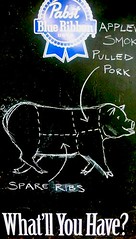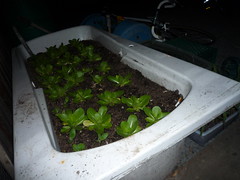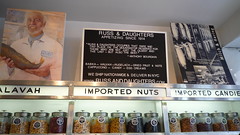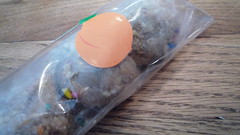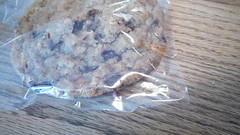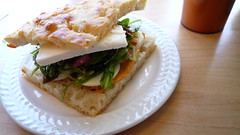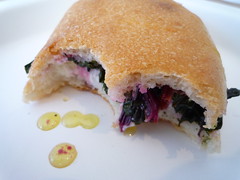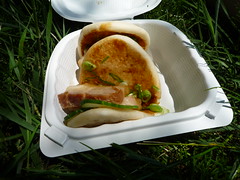Club Med
 fig. a: Neptune knows how to stay cool*
fig. a: Neptune knows how to stay cool*
We didn't have it nearly as bad as many of you to the west and the south, but for a while there, it was so steamy hot that it was affecting activities here in the AEB Test Kitchen. This was not necessarily a bad thing. We're of the persuasion that if it doesn't ever get HOT! at some point in time during the summer, then you really haven't had a summer. And in recent years, here in Montreal, more often than not, that's been the case--we really haven't had much of a summer.
How hot are we talking about? It has to get to the point where all you can think about is grabbing an ice cream cone or going for a swim. And the thought of cooking a meal over a hot stove, or using a hot oven, is just plain out of the question. It's got to get to the point where all you really want is a cool bowl of gazpacho.
We had that kind of weather back in July, and now the heat is back, minus the humidity (ed: I take that back--the humidity's back too). It's not nearly the scorcher that it was last month, but it is hot enough that a cool menu is very much in order.
A few weeks ago, we threw a little dinner for some friends. Now, luckily, it wasn't during the hazy, hot, and humid heights of a heatwave, but it was right after one, so using the stove & oven wasn't really an issue, but we were still leaning towards a meal that could be served at room temperature, and that's when we came up with the following Med spread.
As you may have noticed over the years, we have a tendency here at AEB to come up with meals with strong themes to them. Meals like our grand aïoli. Or our homage to España. Or our DIY cabane à sucre. This time we wanted a meal that had a theme to it, but we didn't want it to be overbearing, we just wanted it to go along with the Provençal wines we'd lined up to drink. We considered going Spanish, or Southern French, or Italian, or Greek. Then we realized, why don't we just go "Med"?
Here are some of the highlights, perfect for a warm, late-summer evening. Ideal for Labor Day weekend...
We've showcased a gazpacho recipe before here at AEB, but that one was a little new-fangled. This one, on the other hand, is as classic as they get--the tomato gazpacho of your dreams. And now is really the time to make it. It's a recipe that calls for the "ripest, most flavorful tomatoes possible," Italian frying peppers and red bell peppers, and all of these ingredients are currently at the height of season.
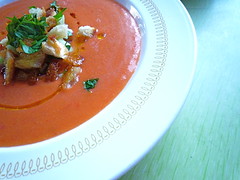 fig. b: gazpacho
fig. b: gazpacho
Classic Gazpacho
2 cups cubed day-old country bread, crusts removed
2 medium-size garlic cloves, chopped
1 small pinch of whole cumin seeds
kosher salt
3 lbs ripest, most flavorful tomatoes possible, seeded and chopped**
2 small cucumbers (Kirby, Lebanese, etc.), peeled and chopped
1 large Italian frying pepper, cored, seeded, and chopped
1 medium-size red bell pepper, cored, seeded, and chopped
3 tbsp chopped red onion
1/2 cup fragrant extra-virgin olive oil
1/2 cup chilled bottled spring water (or filtered tap water)
3 tbsp sherry vinegar, preferably aged, or more to taste
garnishes:
finely diced cucumber
finely diced Italian frying pepper
olive oil croutons (see note)
slivered basil leaves
Place the bread in a bowl, add cold water to cover, and let soak for 10 minutes. Drain the bread, squeezing out the excess liquid.
Place the garlic, cumin, and 1/2 teaspoon salt in a mortar and mash them to a paste using a pestle.
Place the tomatoes, cucumbers, Italian and red peppers, onion, soaked bread, and the garlic paste in a large bowl and toss to mix. Let stand for about 15 minutes. Working in two batches, place the vegetable mixture in a food processor and process until smooth, adding half of the olive oil to each batch. Once each batch is finished, puree it finely in a blender, then transfer it to a large mixing bowl.
When all the gazpacho has been pureed, whisk in the spring water and vinegar. The soup should have the consistency of a smoothie. Taste for seasoning, adding more salt and/or vinegar as necessary. Refrigerate the gazpacho, covered, until chilled, about 2 hours. Serve the soup in bowls with garnishes.
Note: This recipe calls for the crusts of the bread to be removed. Instead of discarding them, use them to make croutons to garnish your soup. Dice the crusts. Heat a tablespoon of olive oil in a skillet over medium heat. Add a crushed garlic clove, and sizzle it for about one minute. Add the crusts and sauté them gently for about 5 minutes, stirring frequently, until they are golden and crispy. Season with a pinch of salt and set aside.
[recipe from Anya von Bremzen's The New Spanish Table]
We were seriously impressed by Saveur's recent special issue on Greece, but we've yet to have the time to work through its many, many tempting recipes. One recipe that's become an instant hit around here, though, is this smoky, spicy melitzanosalata recipe.
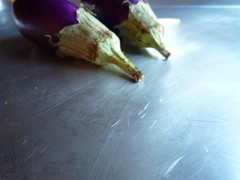 fig. c: Italian eggplants
fig. c: Italian eggplantsMelitzanosalata
2 lbs eggplant, preferably baby Italian eggplants
1/2 cup extra-virgin olive oil
1 green bell pepper, cored and chopped
1 jalapeño pepper, stemmed, seeded, and chopped
1 cup flat-leaf parsley leaves
2 tbsp red wine vinegar
3 cloves garlic, minced
kosher salt
freshly ground black pepper
crusty bread or toasted pita
Build a hot fire in a charcoal grill. Grill the eggplants whole, turning, until charred and soft, about 20 minutes. Let cool. Cut the eggplants in half and scoop out the flesh, discarding as many seeds as possible. Drain the eggplant flesh in a strainer for 30 minutes.
Heat 1/4 cup of the oil in a 12" skillet over medium-high heat. Add the peppers and cook for 10 minutes. Add the jalapeños and continue cooking until golden brown, about 5 minutes. Transfer to the bowl of a food processor along with the eggplant, the remaining oil, the parsley, the vinegar, and the garlic. Process until slightly chunky. Season with salt and pepper. Chill for 30 minutes to meld the flavors. Serve with crusty bread or toasted pita.
[recipe from Saveur, August/September 2010]
A crusty loaf of bread goes well with gazpacho. Melitzanosalata demands fresh bread to sop it up with, and a crusty loaf is just the ticket. Why not make your own? Jim Lahey's now-legendary No-Knead Bread recipe makes it so easy. And the results look like this:
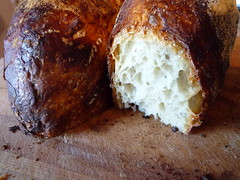 fig. d: god bless no-knead bread!
fig. d: god bless no-knead bread!The A16 cookbook has yet to steer us wrong, and this recipe is what the Lee Bros. call a "Quick Knockout": minimum effort, maximum flavor. The combination of the grilled pork, the soffritto, and the bitter greens is phenomenal, but it's worth checking out the recipe just for the grilled pork technique, which couldn't be any easier, but works some serious magic.
 fig. e: pork loin spiedino
fig. e: pork loin spiedinoPork Loin Spiedino***
2 pounds boneless pork loin, cut into 1-inch cubes
about 1 tbsp kosher salt
1/2 cup dried currants
3/4 cup pine nuts
1/2 cup plus 1 tbsp extra-virgin olive oil
2/3 cup garlic cloves, minced****
3 oz arugula or dandelion greens
wooden skewers
Toss the pork with the salt in a bowl. Cover and refrigerate for at least overnight or up to 3 days.
To make the soffritto, soak the currants in just enough warm water to cover for about 20 minutes.
Meanwhile, add the pine nuts and 1/2 cup of the olive oil to a small, heavy pot and place over low heat. Gradually bring to a low simmer, stirring frequently, and cook, stirring, for about 5-10 minutes, or until the pine nuts have started to turn a golden brown. Stir in the garlic and continue to cook on low heat for about 8 minutes, or until the garlic is a light golden brown. Watch the soffritto carefully--the pine nuts and garlic can burn easily and turn bitter. Drain the currants, add them to the pot, stir and remove the pot from the heat. Let the soffritto cool to room temperature. It will keep, tightly covered, in the refrigerator for 2 weeks.
About 30 minutes before cooking, remove the pork from the refrigerator. Soak the wooden skewers in water. Prepare a hot fire in a grill, stacking the coals to one side so you have two areas of heat, one for direct heat, the other for indirect heat.
Drizzle the remaining 1 tbsp olive oil over the pork and toss to coat evenly. Drain the skewers, and thread about 5 pieces of pork onto each skewer.
Place the skewers over the coals and grill for about 1 minute on each side, or until well-seared. Move the skewers to the cooler side of the grill and continue to cook over indirect heat for 8 to 10 minutes, until cooked medium-well but still juicy.
Arrange a bed of greens on a platter (we've been using dandelion greens, because that's we've got in our garden at the moment, but most bitter greens would do). Place the pork skewers on top. Drizzle some of the soffritto over the top of the pork and the greens. Pass the remaining sauce at the table. Serve immediately while the pork is still hot.
[Recipe from A16: Food + Wine by Nate Appleman and Shelley Lindgren]
There were a number of other small courses, including stuffed zucchini blossoms, mixed olives, and a killer cheese plate, but the dessert was another real highlight. And for that recipe (in your choice of a 140-characters-or-less Twitter version or a standard version), all you have to do is click here.
aj
* He also knows how to party. Thanks to our friends at BibliOdyssey for the lovely image.
** We've neglected to seed the tomatoes on occasion, especially when the tomatoes are at their absolute peak, and we haven't noticed a difference in the deliciousness of the end product.
*** Those of you with ties to the Binghamton, NY might recognize spiedino as the root of the "spiedie" phenomenon.
**** This is a substantial amount of garlic. We've made the recipe with substantially less (say, 3-4 cloves) and found it very satisfactory indeed. But if you're a garlic fiend, and you've got the time, by all means, mince away.


